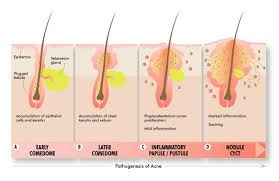Team:Montgomery Cougars NJUSA/Project/PathogenesisofAcne
From 2014hs.igem.org
Joanna.li358 (Talk | contribs) (→Pathogenesis of Acne) |
Casey.chow (Talk | contribs) |
Revision as of 03:33, 20 June 2014
Pathogenesis of Acne
Acne Vulgaris is caused by four main factors:
1. Blockage of sebaceous follicles.
2. The epithelial cells in sebaceous follicles undergo abnormal desquamation (shedding of the skin). Comedogenesis is the obstruction of sebaceous follicles due to greater cohesiveness of the follicular epithelial cells and sebum. As keratinous material gathers in the sebum filled follicle, the wall thins and swells.
3. The anaerobic, commensual bacterium Propionibacterium acnes proliferates in a lipid rich environment, such as when there is an overproduction of sebum. Excessive sebum production is caused by androgenic stimulation of sebaceous glands.
4. P. acnes produces proinflammatory mediators that cause microcomedones to inflame and become papules, pustules, and nodulocystic lesions. A microcomedone is the precursor to acne, an accumulation inside a pore, causing the pore to be plugged by dead skin cells and sebum. Lipases, proteases, and hyaluronidases, produced by the bacteria, act as proinflammatory products.
Acne can manifest itself on the skin in a variety of manners, from mild comedonal form to severe inflammatory cystic on the face, back, and chest. When androgen is released throughout the body, it precipitates activity in the sebaceous glands, promoting comedone and seborrhoea formation, propagating the inflammatory P. acnes. P. acnes is actually present in the pilosebaceous ducts as an anaerobe.

 "
"